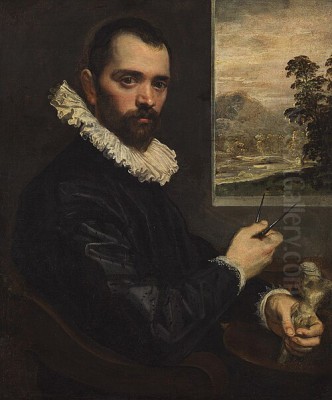
Domenico Robusti, better known as Domenico Tintoretto, stands as a significant figure in the twilight of the Venetian Renaissance and the burgeoning Baroque era. Born into the vibrant artistic milieu of late 16th-century Venice, his life and career were inextricably linked with those of his formidable father, Jacopo Tintoretto. While often viewed through the lens of his father's towering reputation, Domenico carved out his own distinct artistic identity, particularly excelling in portraiture and contributing substantially to the vast output of the Tintoretto workshop, which dominated the Venetian art scene for decades. Understanding Domenico requires appreciating both his role as a devoted son and principal assistant, and his achievements as an independent master who navigated the complex artistic currents of his time.
Early Life and Formative Years in the Shadow of a Giant
Domenico Tintoretto was born in Venice around 1560. He was the eldest son of the renowned painter Jacopo Robusti, famously known as Tintoretto, a nickname derived from his own father's profession as a dyer, or 'tintore'. Domenico grew up immersed in the world of painting, quite literally within the bustling environment of his father's workshop, one of the most productive and influential in Venice. From a very young age, it was clear that Domenico would follow in his father's footsteps.
His artistic education began early and was exclusively under the tutelage of Jacopo. The Tintoretto workshop was not just a place of learning but a demanding production center, and Domenico quickly became an indispensable part of its operation. He absorbed his father's techniques, compositional strategies, and dramatic use of light and shadow (chiaroscuro). By the age of 17, his talent was sufficiently developed for him to be admitted into the Venetian painters' guild in 1577, marking his official entry into the professional art world of the city.

These formative years were characterized by intense collaboration. Domenico learned by doing, assisting his father on numerous large-scale commissions that cemented the Tintoretto name. This hands-on experience was invaluable, providing him with technical proficiency and an intimate understanding of the narrative and devotional requirements of Venetian patrons, both civic and religious. He was not merely an apprentice but a trusted collaborator, increasingly taking on significant portions of major projects.
The Tintoretto Workshop: A Family Affair
Following Jacopo Tintoretto's death in 1594, Domenico inherited the leadership of the highly successful workshop. This was a position he had effectively been groomed for over many years. The Tintoretto studio was remarkable not only for its prolific output but also for its organization, which resembled a family enterprise. Domenico's siblings, notably his sister Marietta Robusti (also a talented painter, particularly known for portraits, who sadly predeceased her father) and his brother Marco, were also involved in the workshop's activities.
Under Domenico's direction, the workshop continued to thrive, fulfilling numerous commissions and maintaining the distinctive Tintoretto style. He managed a team of assistants, ensuring the completion of large canvases for churches, confraternities (Scuole), and the Venetian state. This collaborative model, while efficient, has historically presented challenges for art historians regarding attribution. Distinguishing Domenico's hand from his father's, especially in works from the 1580s and early 1590s, and separating his contributions from those of other workshop assistants, remains a complex task.
Despite these challenges, Domenico proved to be a capable manager and artistic director. He successfully completed projects left unfinished by his father and secured new commissions, ensuring the workshop's continued prominence in Venice well into the 17th century. He maintained the energetic brushwork and dramatic intensity associated with the Tintoretto name, while gradually introducing subtle shifts in style and emphasis.
Independent Master: Commissions and Style
While deeply involved in the workshop, Domenico also developed his career as an independent master. Even during his father's lifetime, he undertook individual commissions. His official registration as a member of the painters' guild from 1594 solidified his independent status. His work spanned the typical genres of the era: large-scale religious narratives, historical paintings, mythological scenes, and, notably, portraiture.
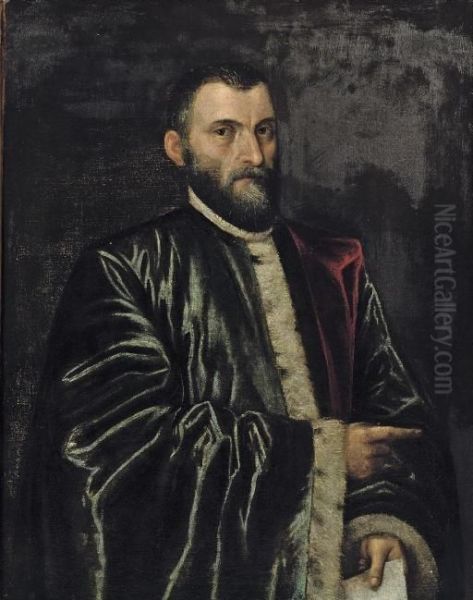
Early in his independent career, he contributed significantly to the redecoration of the Doge's Palace following devastating fires in the 1570s. Working alongside his father and other prominent artists like Paolo Veronese and Palma Giovane, Domenico executed historical canvases celebrating Venetian triumphs, such as the Battle of Salvore and the Second Conquest of Constantinople. These works demonstrate his ability to handle complex, multi-figure compositions in the grand Venetian manner established by masters like Titian and his own father.
Religious commissions formed a substantial part of Domenico's oeuvre. He received numerous contracts from Venetian churches and religious institutions. Notable examples include works for the church of Sant'Andrea della Zirada, such as a Last Supper and a Crucifixion, and the Marriage of the Virgin for San Giorgio Maggiore. These paintings often echo his father's dramatic intensity but sometimes display a slightly softer modeling of figures and a different emotional tenor. He continued to employ the dynamic compositions and bold contrasts of light and dark that were hallmarks of the Tintoretto style.
Artistic Style: Continuity and Individuality
Domenico's artistic style is inevitably compared to his father's. He inherited Jacopo's penchant for dramatic, often tumultuous compositions, energetic brushwork (prestezza), and the powerful use of chiaroscuro to heighten emotional impact and define form. He learned his father's innovative techniques, such as using small wax or clay models arranged on miniature stages to study the effects of light and composition before starting a large canvas. This practice contributed to the theatricality and complex spatial arrangements seen in many Tintoretto workshop productions.
However, Domenico was not a mere imitator. While adhering to the established family style, particularly in large narrative works likely intended to meet patron expectations for a "Tintoretto," his independent works reveal a distinct artistic personality. Some critics note a tendency towards more elongated figures compared to Jacopo's muscular forms. His color palette, while still rich and often employing deep shadows, could sometimes differ subtly from his father's, occasionally incorporating elements perhaps influenced by contemporaries like the Bassano family (Jacopo Bassano and his sons, particularly Leandro Bassano).
His use of preparatory sketches, often executed rapidly in oil on paper, sometimes using distinctive reddish-brown tones, was also characteristic and influential. This technique allowed for quick exploration of compositional ideas and became increasingly common among artists in the following century, foreshadowing aspects of Baroque dynamism. While Jacopo's work often possesses an almost overwhelming spiritual intensity and raw energy, Domenico's interpretations could be perceived as slightly more controlled or perhaps more focused on narrative clarity, though still imbued with considerable dramatic force.
The Master Portraitist
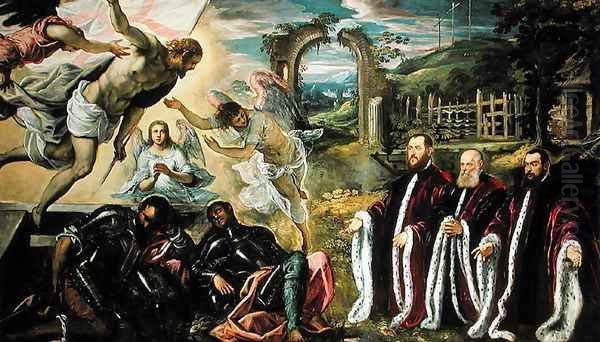
Where Domenico Tintoretto arguably stepped furthest out of his father's shadow and achieved his most personal and acclaimed artistic statements was in the field of portraiture. While Jacopo was also a capable portraitist, Domenico developed a particular sensitivity and skill in capturing the likeness and, more importantly, the psychological presence of his sitters. Venice, as a major center of commerce and government, had a high demand for portraits among its nobility, senators, merchants, and visiting dignitaries.
Domenico excelled at meeting this demand. His portraits are often characterized by their directness, sober realism, and insightful rendering of individual character. He moved beyond the purely representative function of portraiture to explore the inner life of his subjects. Works like the Portrait of a Senator (the specific identity often debated, but the quality undeniable) showcase his ability to convey gravitas, intelligence, and a sense of lived experience through subtle facial expression, posture, and the handling of light on features and rich fabrics.
His skill in this genre was widely recognized, and his portraits were highly sought after. Art historians often consider his best portraits to be on par with those of the greatest masters of the era, comparing his psychological acuity to that found in works by artists like Rembrandt van Rijn or Diego Velázquez, though his style remained distinctly Venetian. He captured the dignity and authority expected of official portraits but infused them with a human warmth and individuality that makes them compelling even today. This mastery cemented his reputation independently of the large narrative works produced by the workshop.
Notable Works and Their Significance
Several key works highlight Domenico Tintoretto's style and contributions:
Paradise (Il Paradiso), Doge's Palace, Venice: While primarily designed and begun by Jacopo, Domenico played a crucial role in completing this colossal canvas (one of the largest oil paintings ever created) after his father's death. It covers the entire wall behind the Doge's throne in the Hall of the Great Council. Its teeming composition, depicting hundreds of figures swirling towards the central image of Christ and the Virgin, embodies the late Tintoretto workshop style – a vortex of energy, light, and spiritual fervor. Domenico's task in bringing this monumental vision to fruition was immense.
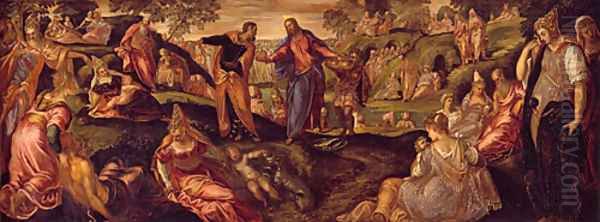
Translation of the Body of St. Mark (Traslazione del corpo di San Marco): This subject, central to Venetian identity, was painted multiple times by the Tintoretto workshop. Domenico's versions continue the tradition established by his father, employing dramatic perspective, ghostly apparitions, and stark contrasts of light and shadow to convey the miraculous event and the chaos surrounding it. These works showcase the Tintorettesque ability to blend the earthly and the divine in a highly theatrical manner.
St. George Slaying the Dragon: A theme popular in Venetian art, Domenico's interpretations often feature the characteristic energy and dynamic composition associated with his father, but sometimes with a focus on landscape or a slightly different narrative emphasis. It demonstrates his handling of mythological or legendary subjects with vigor.
Portraits: As mentioned, numerous portraits stand as testaments to his skill. Examples include portraits of Venetian senators, procurators, Doges (like Doge Marino Grimani), and intellectuals. Each aims to capture the specific identity and social standing of the sitter while revealing something of their personality. These works are often less overtly dramatic than the narrative paintings but possess a quiet intensity.
Religious Works for Venetian Churches: Paintings like the Last Supper or Crucifixion for Sant'Andrea della Zirada, or works for San Giorgio Maggiore, demonstrate his continued engagement with devotional themes. They often follow established Tintoretto compositional patterns but are executed with his own hand and sensibility, contributing significantly to the artistic fabric of Venice's sacred spaces.
Collaborations, Contemporaries, and Context
Domenico Tintoretto worked during a period of transition in Venetian art. The towering figures of the High Renaissance, Titian and his own father Jacopo Tintoretto, along with their great contemporary Paolo Veronese, had established Venice as a powerhouse of color (colorito) and dramatic composition. Domenico inherited this legacy but also worked alongside the next generation.
His most significant collaborator was, of course, his father. However, he also interacted and sometimes collaborated on large projects (like the Doge's Palace decorations) with Palma Giovane, another leading Venetian painter who was heavily influenced by Jacopo Tintoretto but developed his own distinct, slightly more classical style. The Bassano family workshop, known for its genre scenes and distinctive use of light, also operated concurrently, and stylistic exchanges likely occurred.
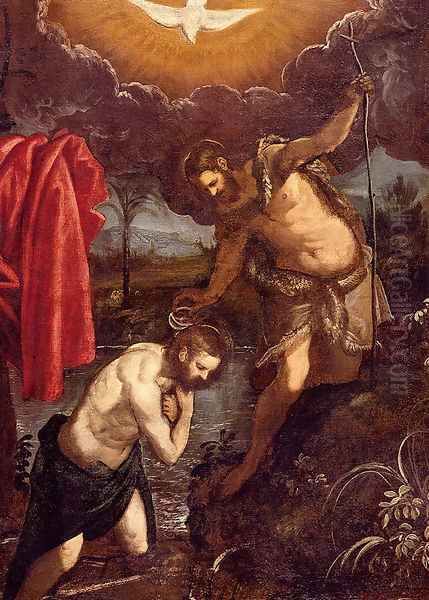
Domenico's work also shows an awareness of artistic developments elsewhere, although he himself rarely traveled outside Venice. His engagement with portraiture reflects broader European trends in the genre. While firmly rooted in the Venetian tradition, his dramatic use of light and dynamic compositions can be seen as contributing to the currents that would feed into the full-blown Baroque style emerging in Rome and elsewhere, championed by artists like Caravaggio and later Gian Lorenzo Bernini, although Domenico's own style remained fundamentally tied to late Mannerist and Venetian principles.
He also reportedly collaborated with or employed Northern European artists who passed through Venice, contributing to the cross-cultural exchanges that enriched the city's artistic life. His position as head of a major workshop placed him at the center of artistic production and patronage in Venice for several decades.
Later Life, Death, and Legacy
Domenico Tintoretto remained active as a painter and head of the workshop for many years after his father's death. He continued to receive prestigious commissions and maintained the family's artistic reputation. He upheld the traditions of Venetian narrative painting while solidifying his personal renown as a portraitist. Anecdotal evidence suggests he was deeply affected by the loss of family members, including his father and talented sister Marietta. He himself lived a long life dedicated almost entirely to his art within his native city.
He died in Venice on May 17, 1635, and was buried in the family tomb in the church of Madonna dell'Orto, the same church that houses several of Jacopo Tintoretto's masterpieces. With Domenico's death, the direct Tintoretto artistic dynasty effectively came to an end, although the workshop's influence persisted.
Domenico Tintoretto's legacy is complex. For centuries, he was somewhat overshadowed by his father's colossal reputation. His collaborative role and the workshop system led to attribution difficulties that sometimes obscured his individual contributions. However, modern art history has increasingly recognized his distinct talents and importance. He was a crucial figure in transmitting the Tintoretto style into the 17th century and a master portraitist in his own right. His work represents a vital link between the late Venetian Renaissance/Mannerism and the emerging Baroque, demonstrating both continuity with the great tradition of Titian, Veronese, and Jacopo Tintoretto, and his own unique artistic voice. His paintings continue to adorn the churches and palaces of Venice, a testament to a lifetime spent in service to art and the legacy of his family name.